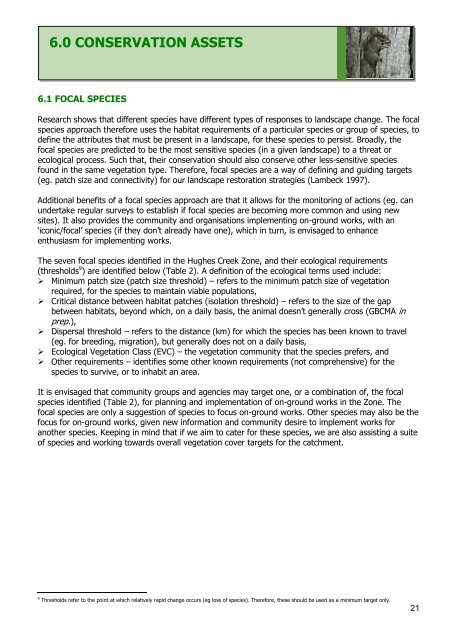Conservation Plan Hughes Creek Landscape Zone - Strathbogie ...
Conservation Plan Hughes Creek Landscape Zone - Strathbogie ...
Conservation Plan Hughes Creek Landscape Zone - Strathbogie ...
You also want an ePaper? Increase the reach of your titles
YUMPU automatically turns print PDFs into web optimized ePapers that Google loves.
6.0 CONSERVATION ASSETS<br />
6.1 FOCAL SPECIES<br />
Research shows that different species have different types of responses to landscape change. The focal<br />
species approach therefore uses the habitat requirements of a particular species or group of species, to<br />
define the attributes that must be present in a landscape, for these species to persist. Broadly, the<br />
focal species are predicted to be the most sensitive species (in a given landscape) to a threat or<br />
ecological process. Such that, their conservation should also conserve other less-sensitive species<br />
found in the same vegetation type. Therefore, focal species are a way of defining and guiding targets<br />
(eg. patch size and connectivity) for our landscape restoration strategies (Lambeck 1997).<br />
Additional benefits of a focal species approach are that it allows for the monitoring of actions (eg. can<br />
undertake regular surveys to establish if focal species are becoming more common and using new<br />
sites). It also provides the community and organisations implementing on-ground works, with an<br />
<br />
enthusiasm for implementing works.<br />
The seven focal species identified in the <strong>Hughes</strong> <strong>Creek</strong> <strong>Zone</strong>, and their ecological requirements<br />
(thresholds 9 ) are identified below (Table 2). A definition of the ecological terms used include:<br />
‣ Minimum patch size (patch size threshold) refers to the minimum patch size of vegetation<br />
required, for the species to maintain viable populations,<br />
‣ Critical distance between habitat patches (isolation threshold) refers to the size of the gap<br />
in<br />
prep.),<br />
‣ Dispersal threshold refers to the distance (km) for which the species has been known to travel<br />
(eg. for breeding, migration), but generally does not on a daily basis,<br />
‣ Ecological Vegetation Class (EVC) the vegetation community that the species prefers, and<br />
‣ Other requirements identifies some other known requirements (not comprehensive) for the<br />
species to survive, or to inhabit an area.<br />
It is envisaged that community groups and agencies may target one, or a combination of, the focal<br />
species identified (Table 2), for planning and implementation of on-ground works in the <strong>Zone</strong>. The<br />
focal species are only a suggestion of species to focus on-ground works. Other species may also be the<br />
focus for on-ground works, given new information and community desire to implement works for<br />
another species. Keeping in mind that if we aim to cater for these species, we are also assisting a suite<br />
of species and working towards overall vegetation cover targets for the catchment.<br />
9 Thresholds refer to the point at which relatively rapid change occurs (eg loss of species). Therefore, these should be used as a minimum target only.<br />
21


